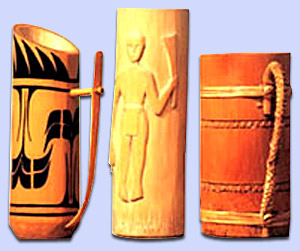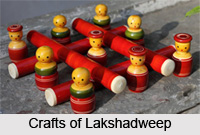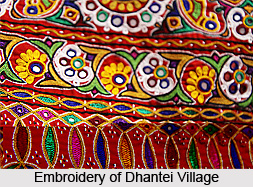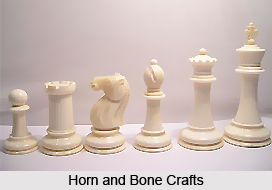 Horn and Bone craft is the cultural heritage of the artisans of Paralakhemundi, located in the Gajapati district of Orissa. The artisans were originally carpenters by birth and profession but turned to horn and bone crafts during the reign of Sri Krushna Chandra Gajapati Narayan Deb, the Maharaja of Paralakhemundi.
Horn and Bone craft is the cultural heritage of the artisans of Paralakhemundi, located in the Gajapati district of Orissa. The artisans were originally carpenters by birth and profession but turned to horn and bone crafts during the reign of Sri Krushna Chandra Gajapati Narayan Deb, the Maharaja of Paralakhemundi.
Origin of Horn and Bone Craft
The origin of Horn and Bone Craft has not yet been deciphered. It is believed that K. V. Appa Rao is the father of horn craft in its present form. Maharaja of Paralakhemundi patronized him for his craftworks, especially for a particular variety in which the hollow part of the horns was used as a container. Once the king came across an exquisitely carved wooden crane and was inspired to get a similar one made of horn. The same was carved out of the solid part of a horn which highly pleased the Maharaja. Appa Rao with his innate business acumen assessed the potentiality of the craft and set up a workshop. Efforts were made to introduce new designs and more sophisticated tools. Since then, the very word Paralakhemundi became synonymous with horn craft.
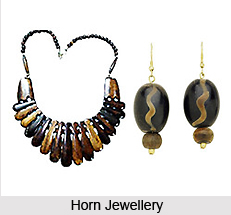 Artefacts of Horn and Bone Craft
Artefacts of Horn and Bone Craft
Horn articles of Paralakhemundi are mystical and are embellished with superb designs. The testaments of this brilliant craftwork include stylized birds and animals which seem alive. For instances, cranes look as if they could talk if they opened their beaks and the birds appear to be twittering. Delicate works of silver filigree are sometimes added to the horn articles to make them even more appealing. Items like bangles, perfume jars, traditional combs, jewellery, tobacco pipes and many other artefacts are also furnished by this craftwork. In Cuttack horn and filigree works are combined to produce decorative jewelleries. Other important centres include Sarai Tarin in Uttar Pradesh, Honawar in Karnataka and Thiruvananthapuram in Kerala. The craftsmen of Thiruvananthapuram are famous for making different kinds of crane birds with horns. Pen stands, table lamps, paper weights, lamp shades, snuff boxes, walking sticks, vermilion contain are other common products. However, the list remains incomplete without the mention of the horn deities, especially Lord Jagannath. Influences of both ancient and modern arts can be seen in the artefacts of Horn and Bone Crafts. Flora and fauna, mythical figures and, in fact, the entire gamut of creation can be witnessed in this craftwork.
Making of Horn Crafts
Cow horns, Buffalo horns, stag antlers and tusks are used in horn crafts. The desired object is carved out from the solid part of a horn after soaking it in water. For further shaping, the carved pieces are heated to a specific temperature and are softened. The surface is then smoothed down with the help of a rough file, flat file, half round file or a sharp stainless steel blade. Necessary bores are made to fix appendages. Polishing is the next step in the making of these crafts which is done by rubbing the articles first with sand paper and then with wet Khrshana leaves. The polishing is continued till the horn becomes smooth and shiny. These are then thoroughly cleansed with water and dried in open air. After drying these are further polished with cow dung ash or charcoal ash. Applying limestone paste or white varnish highlights the desired areas. Finally coconut oil is smeared all over the artefact to render a beautiful sheen.
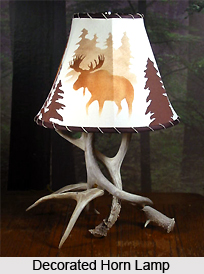 Making of Bone Crafts
Making of Bone Crafts
Similar to the horn crafts, making of bone crafts also involves a series of elaborate procedures. Raw bones of dead animals are firstly cut into desired sizes and are immersed in water for 12 hours. This process softens the bone. Later these pieces are scrapped and cleaned and are shaped according to the artefact, on a lathe. Carving is done with the aid of a file drill. Polishing, colouring and designing of these articles in varied patterns are the final steps in the making of bone crafts.
Designs of Horn and Bone Craft
Designs on the bone carving exhibit a variety of motifs including floral and figurative patterns. Influences of Mughal architecture can also be traced on these crafts. Initially, ornaments were prepared with natural bones, but later use of vibrant colours became an alluring fashion. Some of the artefacts are also adorned with natural stones like feroza, topaz, quartz etc which augment their elegance and beauty.
Numerous articles including jewellery, ornate table lamps, chess-sets, cigarette holders, napkin rings, salt and pepper sets, laughing Buddha, chess sets, animal figures, decorative plaques, bridges of animals, paper cutters, tooth picks, hair pins, bangles, lockets, necklaces, figures depicting Indian dances etc are the mesmerizing manifestations of Horn and Bone Crafts. The charm of this craftwork fascinates people not only of the county but also of different parts of the world, irrespective of age groups and cultural backgrounds. With the help of a number of adept artisans, India has acquired considerable fame in Horn and Bone Crafts, all over the world.



